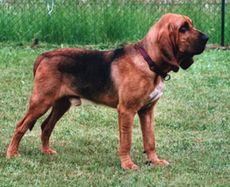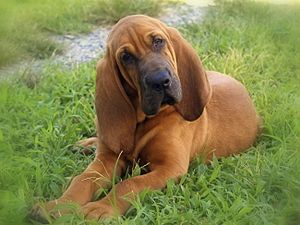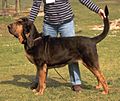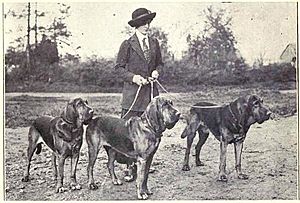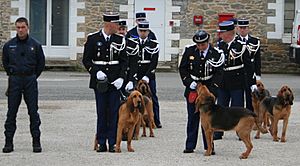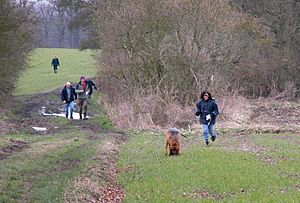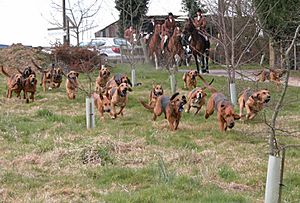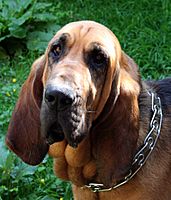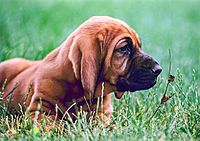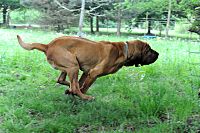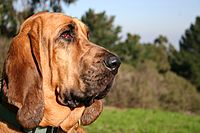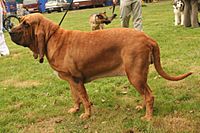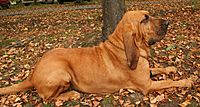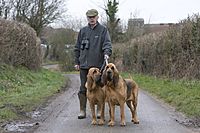Bloodhound facts for kids
The bloodhound is a large breed of dog famous for its incredible tracking ability by scent. It stands 23–27 inches (58–69 cm) and weighs 80–110 pounds (36–50 kg). It has a long nose, large ears with wrinkles on its face. Its fur is short and its coat is usually a brown and black color. Bloodhounds are usually a gentle and affectionate breed. The Bloodhound lives an average of six years and nine months. Bloodhounds are often used by police because of its tracking ability.
Contents
Appearance
Bloodhounds weigh from 36 to 72 kg (80 to 160 lbs).They are 58 to 69 cm (23 to 27 inches) tall at the withers. According to the AKC standard for the breed, larger dogs are preferred by conformation judges. Acceptable colors for bloodhounds are black, liver, tan, and red. Bloodhounds possess an unusually large skeletal structure with most of their weight concentrated in their bones, which are very thick for their length. The coat typical for a scenthound is hard and composed of fur alone, with no admixture of hair.
Temperament
This breed is gentle, and is tireless when following a scent. Because of its strong tracking instinct, it can be willful and somewhat difficult to obedience train and handle on a leash. Bloodhounds have an affectionate and even-tempered nature with humans, making excellent family pets. However, like any pet, they require supervision when around small children.
Colour types
Up to at least the seventeenth century bloodhounds were of all colours, but in modern times the colour range has become more restricted. The colours are usually listed as black and tan, liver and tan, and red. White is not uncommon on the chest, and sometimes appears on the feet. Genetically, the main types are determined by the action of two genes, found in many species. One produces an alternation between black and brown (liver). If a hound inherits the black allele (variant) from either parent, it has a black nose, eye rims and paw-pads, and if it has a saddle, it is black. The other allele suppresses black pigment and is recessive, so it must be inherited from both parents. It produces liver noses, eye rims, paw-pads, and saddles.
The second gene determines coat pattern. It can produce animals with no saddle (essentially all-tan, but called ‘red’ in bloodhounds); ones with saddle-marking; or ones largely covered with darker (black or liver) pigment, except for tan lips, eyebrows, forechest and lower legs. These last are sometimes referred to as ‘blanket’ or ‘full-coat’ types. In a pioneering study in 1969 Dennis Piper suggested 5 alleles in the pattern-marking gene, producing variants from the red or saddle-less hound through three different types of progressively greater saddle marking to the ‘blanket’ type. However, more modern study attributes the variation to 3 different alleles of the Agouti gene. Ay produces the non saddle-marked "red" hound, As produces saddle-marking, and at produces the blanket or full-coat hound. Of these Ay is dominant, and at is recessive to the others. The interaction of these variants of the two genes produces the six basic types shown below.
It is likely that a third gene determines whether or not there is a melanistic mask. Em, the allele for a mask, is dominant over E, the allele for no mask.
Lifespan
Bloodhounds in a 2004 UK Kennel Club survey had a median longevity of 6.75 years, which makes them one of the shortest-lived of dog breeds.
History
Chien de Saint-Hubert
The St. Hubert hound was, according to legend, first bred ca. 1000 AD by monks at the Saint-Hubert Monastery in Belgium; its likely origins are in France, home of many of modern hounds. It is held to be the ancestor of several other breeds, like the extinct Norman hound, and Saintongeois, and the modern Grand Bleu de Gascogne, Gascon Saintongeois, Ariegeois and Artois Normande, as well as the bloodhound. It has been suggested that it was a dog of mixed breeding, not at all uniform in type.
Whether they originated there, or what their ancestry was, is uncertain, but from ca. 1200, the monks of the Abbey of St Hubert annually sent several pairs of black hounds as a gift to the King of France. They were not always highly thought of in the royal pack. Charles IX 1550-74, preferred his white hounds and the larger Chiens-gris, and wrote that the St Huberts were suitable for people with gout to follow, but not for those who wished to shorten the life of the hunted animal.
They appear to have been more highly thought of during the reign of Henry IV (1553–1610), who presented a pack to James I of England. By the end of the reign of Louis XIV (1715), they were already rare. In 1788, D’Yauville, who was master of the Royal hounds, says those sent by the St Hubert monks, once much prized, had degenerated, and scarcely one of the annual gift of six or eight was kept.
Writers on the bloodhound in the last two centuries generally agreed that the original St Hubert strain died out in the nineteenth century, and that the European St Hubert owes its present existence to the development of the Bloodhound.
Bloodhound
References to bloodhounds first appear in English writing in the early to mid 14th century, in contexts that suggest the breed was well established by then. It is often claimed that its ancestors were brought over from Normandy by William the Conqueror, but there is no actual evidence for this. That the Normans brought hounds from Europe during the post-Conquest period is virtually certain, but whether they included the Bloodhound itself, rather than merely its ancestors, is a matter of dispute that probably cannot be resolved on the basis of surviving evidence.
In Medieval hunting the typical use of the Bloodhound was as a ‘limer’, or ‘lyam-hound’, that is a dog handled on a leash or ‘lyam’, to find the hart or boar before it was hunted by the pack hounds (raches). It was prized for its ability to hunt the cold scent of an individual animal, and, though it did not usually take part in the kill, it was given a special reward from the carcass.
It also seems that from the earliest times the Bloodhound was used to track people. There are stories written in Medieval Scotland of Robert the Bruce (in 1307), and William Wallace (1270–1305) being followed by 'sleuth hounds’. Whether true or not, these stories show that the sleuth hound was already known as a man-trailer, and it later becomes clear that the sleuth hound and the Bloodhound were the same animal.
With the rise of fox-hunting, the decline of deer-hunting, and the extinction of the wild boar, as well as a more settled state of society, the use of the Bloodhound diminished. It was kept by the aristocratic owners of a few deer-parks and by a few enthusiasts, with some variation in type, until its popularity began to increase again with the rise of dog-showing in the 19th Century.
During the later 19th century numbers of Bloodhounds were imported from Britain by French enthusiasts, who regretted the extinction of the ancient St Hubert. They wished to re-establish it, using the Bloodhound, which, despite its developments in Britain, they regarded as the St Hubert preserved unchanged.
When the first Bloodhounds were exported to the USA is not known. Bloodhounds were used to track runaway slaves before the American Civil War, but it has been questioned whether the dogs used were genuine Bloodhounds. However, in the later part of the 19th century, and in the next, more pure Bloodhounds were introduced from Britain, and bred in America, especially after 1888, when the English breeder, Edwin Brough, brought three of his hounds to exhibit at the Westminster KC show in New York City. Bloodhounds in America have been more widely used in tracking lost people and criminals - often with brilliant success - than in Britain, and the history of the Bloodhound in America is full of the man-trailing exploits of outstanding Bloodhounds and their expert handlers, the most famous hound being Nick Carter. Law enforcement agencies have been much involved in the use of Bloodhounds.
In Britain there have been instances from time to time of the successful use of the Bloodhound to track criminals or missing people.
Meanwhile, the Bloodhound has become widely distributed internationally, though numbers are small in most countries, with more in the USA than anywhere else. Following the spread of the Bloodhound from Britain in the nineteenth and twentieth centuries, imports and exports and, increasingly, artificial insemination, are maintaining the world population as a common breeding stock, without a great deal of divergence in type in different countries.
Working the Bloodhound
Scenting ability
The Bloodhound's physical characteristics account for its ability to follow a scent trail left several days in the past. Under optimal conditions, a Bloodhound can detect as few as one or two cells. In some dog breeds, such as bloodhounds, the olfactory sense has nearly 300 million receptors.
The large, long pendent ears serve to prevent wind from scattering nearby skin cells while the dog's nose is on the ground; the folds of wrinkled flesh under the lips and neck—called the shawl—serve to catch stray scent particles in the air or on a nearby branch as the bloodhound is scenting, reinforcing the scent in the dog's memory and nose. However, not all agree that the long ears and loose skin are functional, some regarding them as a handicap.
Human trailing
There are many accounts of bloodhounds successfully following trails many hours, and even several days old, the record being of a family found dead in Oregon, in 1954, over 330 hours after they had gone missing. The bloodhound is generally used to follow the individual scent of a fugitive or lost person, taking the scent from a ‘scent article’ – something the quarry is known to have touched, which could be an item of clothing, a car seat, an identified footprint etc. Many bloodhounds will follow the drift of scent a good distance away from the actual footsteps of the quarry, which can enable them to cut corners and reach the end of the trail more quickly. In America, sticking close to the footsteps is called ‘tracking’, while the freer method is known as ‘trailing’ (in the UK, ‘hunting’), and is held to reflect the bloodhound’s concentration on the individual human scent, rather than that of, say, vegetation crushed by the feet of the quarry. Having lost a scent, a good bloodhound will stubbornly cast about for long periods, if necessary, in order to recover it. The bloodhound is handled on a tracking harness, which has a metal ring above the shoulders, to which a leash is attached, so that the hound’s neck is not jerked up when the leash becomes taut, as it would with a collar. The leash is at least long enough to allow the hound to cross freely in front of the handler, some handlers preferring quite a short leash, giving better communication with the hound, others liking something longer, maybe twenty or thirty feet.
Training
It is generally agreed that the basis of initial training is to make the experience enjoyable for the puppy or young hound, to keep its enthusiasm high. Whitney preferred waiting till the hound is 18 months old, to start training, but others start as young as possible, say three months. Training can be started by running short trails on a family member whom the puppy sees walk away, at first remaining visible, and later going out of sight. Even though familiar with the scent of the ‘runner’, it can be given a scent-article to sniff, and given the command to follow. It can also be introduced to the tracking harness, which is put on just before the trail starts, and removed as soon as it is finished. On reaching the runner the puppy is given lavish praise and perhaps a reward. Generally in training the handler must know exactly where the runner went, so that he does not encourage the hound when it is wrong, or ‘correct’ it when it is on the scent, but he should not be too ready with his corrections if the hound goes astray, or it may come to rely on him. He should give the hound time to realise its mistake and put itself right, if possible. As training progresses the handler learns to ‘read’ his hound’s behaviour. The hound must trust its nose and the handler must trust the hound. From early hot trails on a familiar person, the young hound progresses to colder trails on the scents of strangers. Later training can be designed to teach particular lessons: crossing trails with false scents, having the runner start out with a companion, who leaves him somewhere along the trail, laying a trail on ground frequented by wild animals. This will teach the hound not to change on to other humans, or riot on animal scents (known as ‘staying clean’ [US], or ‘freedom from change’ [UK]). It also needs to work over a variety of ground and learn to cope with distractions of many kinds, as well as being introduced to 'negative trails': given a scent article which has not been handled by anyone in the area, so that it will learn to indicate to a handler that the required scent is not there. If it is becoming discouraged it can revert to simpler tasks to recover enthusiasm.
Identification
Canine identification of a suspect can help police with their inquiries, and evidence of identification is accepted in some courts. The most approved method of identification is for the hound to jump up, and place its paws on the subject’s chest. In the case of a lost person or a known fugitive identification will not be significant, and in the case of a potentially violent, possibly armed, fugitive a bloodhound handler will not want his dog to approach the quarry for fear of injury to the bloodhound. Many bloodhounds reaching the end of a trail will show no interest in the person they have been trailing, and are difficult to train to identify. Leon Whitney recommended a method of initial training in which identification was the first thing learned, based on giving the young hound a scent-article from someone who walks a very short distance out of sight into a barn, where he stands with a piece of liver, while another person, also smelling of liver, stands nearby. The hound is led along the 'trail', and if it shows an inclination to go to the wrong person it is chastised, but gets the liver if it goes to the right one. When the hound goes to the right person almost infallibly, the number of people is increased, making the choice more difficult, and eventually the brief walks are extended into full trails.
Voice
A common misconception is that Bloodhounds are employed in packs; while this is sometimes the case in Britain, where foxhound blood is mixed into them to increase speed, in North America, Bloodhounds are used as solitary trackers. When they are on a trail, they are usually silent and do not give voice as other scenthounds. The original use of the Bloodhound as a leash-hound, to find but not disturb animals, would require silent trailing.
Nevertheless, the Bloodhound bay is among the most impressive of hound voices. When hunting in a pack they are expected to be in full cry. They are more likely to 'give tongue,' 'throw their tongue,' or 'speak' when hunting in a pack than when hunting singly, and more when hunting free than when on the leash. The quality of 'speaking to the line', that is giving tongue when on the correct scent while remaining silent when off it, is valued in British Bloodhound circles, on aesthetic grounds and because it makes it very easy to 'read' the hound's tracking behaviour. As a result, special trophies for speaking to the correct line are on offer at British working trials (where hounds hunt singly), although rarely awarded.
Trials in Britain
Bloodhound Working Trials, first held in 1898, take place in Britain four times a year, under Kennel Club rules, organised by either the Association of Bloodhound Breeders, or The Bloodhound Club. They are run over farm land by permission of the landowners. A line-walker (runner) is given a map, and sets off to follow a course marked on it, leaving a scent-article ('smeller') attached to a flag marking the beginning of the trail. A hound and its handler start a set time later, and try to follow his trail, while the judge, equipped with a copy of the map, follows behind assessing their performance. When each of the entered hounds has completed a trail, he picks a winner. There are a series of 'stakes' of increasing difficulty, the simplest being 1 mile long, ½ an hour cold, and the hardest 3 miles long, 2 hours cold. On winning a stake, a hound moves up to the next one. Hounds may work unleashed if they have passed a test showing they will not bother farm stock, especially sheep. Special prizes are on offer for identification and voice ('speaking to the line'). The best hounds may be invited to take part in special stakes, the most difficult being 3 miles long, 24 hours cold.
Bloodhound packs
The Medieval Bloodhound was not primarily a pack hound, but a leash hound, though there may have been packs in different places or at different times. Up to the 19th century, a single hound or a brace was used on deer-parks, to find deer for the gun. However, mid century two packs appeared, that of Thomas Neville, who hunted in the New Forest area, and who preferred very black hounds, and that of Lord Wolverton. Both of these hunted semi-domesticated deer (‘carted deer’), which were recaptured on being brought to bay, and returned home. It was said of Lord Wolverton's hounds that he found it difficult to get them to hunt as a pack, because each liked to follow the scent on his own. Eventually, many were sold to Le Couteulx de Canteleu and taken to France. Around the start of the 20th century, several packs existed briefly, following either deer, or the ‘clean boot’ - individual human scent without any enhancement such as animal blood or aniseed. Since the Second World War there have been several packs, including that of Eric Furness, who introduced a cross to a Dumfriesshire foxhound into his Peak Bloodhounds. Generally, masters of Bloodhounds since then maintain a level of outcross breeding in their packs to improve speed and agility, while retaining bloodhound type. These packs hunt the clean boot and are followed by a field on horseback.
Noteworthy Bloodhounds
Grafton was the Bloodhound in Landseer's famous painting Dignity and Impudence(1839). Both dogs in the picture belonged to Jacob Bell.
Mr T A Jennings' Ch Druid, known as 'Old Druid' was the first Bloodhound champion. Born in 1857, he was later bought by Emperor Napoleon III for his son, Prince Eugene Louis Jean Joseph, and taken to France. Photographs of him, of another famous hound, Cowen's Druid, and a bitch named Countess, appear in a rare book from 1865 in the British Library, and may be the oldest photographs of bloodhounds to have survived.
A Bloodhound named Nick Carter is frequently cited as the archetype of the trailing Bloodhound and the extensive publicity this dog received may be the source of much bloodhound-related folklore. Born in 1900, Nick Carter was owned and handled by Captain G.V. Mullikin of Lexington, Kentucky; he is credited with more than 650 finds, including one that required him to follow a trail 300 hours old, that is 12 days.
Ch. Heathers Knock on Wood, known as Knotty, was one of the most awarded Bloodhounds of all time.He received more Best-in-Shows than any other bloodhound, and is the first liver-and-tan Bloodhound ever to win a Best-in-Show. Knotty was awarded Best-in-Show at the Eukanuba Tournament in 2005 and won the Hound Group in the Westminster Kennel Club Show the same year. Knotty's offspring have also been showdogs, and as a result many of his puppies receiving the title of "Champion" by the AKC, Knotty was inducted into the AKC's Stud Dog Hall of Fame. He died in the Spring of 2008, from a rattlesnake bite, which he suffered while trying to protect his owner from the snake.
On the popular 1960s sitcom Beverly Hillbillies, veteran canine actor Stretch portrayed Jed's Bloodhound Duke.
The US Army 615th Military Police Company's mascot is a Bloodhound named for the company's pet and mascot during Vietnam named Andy.
- Bloodhound
Fictional bloodhounds
- Pluto, pet of Mickey Mouse, officially a mixed-breed dog, but designed after a pair of bloodhounds from The Chain Gang (1930)
- Ol' Red, from the George Jones song of the same name (later remade by Blake Shelton)
- Ladybird from King of the Hill
- Beauregard in Pogo
- Pedro, the bloodhound owned and used by the English detective Sexton Blake
- Henry, a bloodhound in a popular series of British TV dog food commercials, with Clement Freud
- Rex in Sofia the First
- Trusty in Lady and the Tramp and Lady and the Tramp 2
- Snuffles in Quick Draw McGraw
- Napoleon in The Aristocats
- Duke, Jed's bloodhound in The Beverly Hillbillies
- Hubert in Best in Show
- Bobby Lee and others in Virginia Lanier's Bloodhound series
- Buddy in Cats & Dogs
- Bruno in Cinderella and Cinderella 2
- The Bumpuses' hounds in A Christmas Story and My Summer Story
- Woofer and Whimper in Clue Club
- McGruff the Crime Dog
- Jasper T. Jowls at Chuck E. Cheese's Pizza
- Achoo from the Provost's Dog trilogy by Tamora Pierce
- General Pepper from Star Fox, by Nintendo videogame
- Everett from Back at the Barnyard
- Pommes Frites, companion of Michael Bond's culinary detective, Monsieur Pamplemousse
- Copper in The Fox and the Hound
- Waylon and Floyd in The Fox and the Hound 2
- Sniffer in Santa Buddies: The Legend of Santa Paws
- Old Tweock in 101 Dalmatians II: Patch's London Adventure
- Laughing Dog in Duck Hunt, a Nintendo video game
- Bayard Hamar in the 2010 film Alice in Wonderland
- B.H. (Calcutta) Failed, a bloodhound that lost its sense of smell, in The Perishers, cartoon strip published in The Daily Mirror
- Beauregard Jr. in Hee Haw
- Sheriff Cooley's bloodhound in O Brother, Where Art Thou?
- Sergeant Murphy in The Busy World of Richard Scarry and Busytown Mysteries, by Richard Scarry
Images for kids
See also
 In Spanish: Perro de San Huberto para niños
In Spanish: Perro de San Huberto para niños


